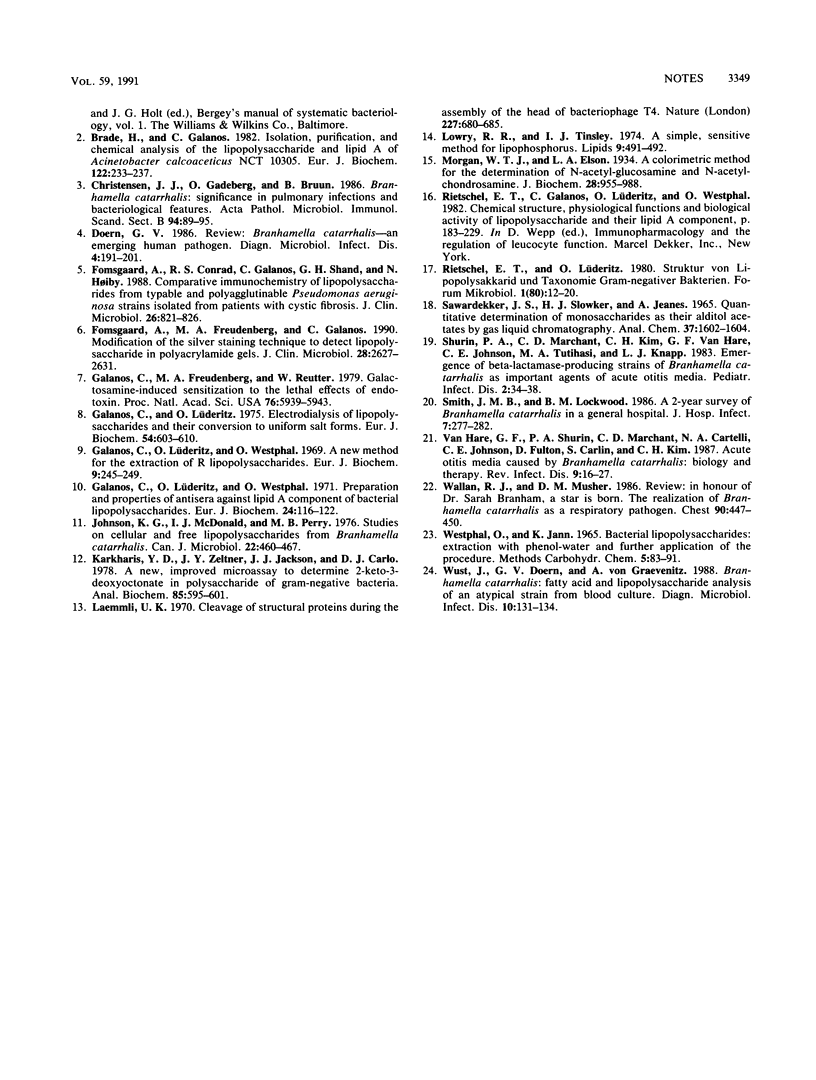Abstract
Lipopolysaccharides (LPS) were extracted and purified from the type strain and from a clinical isolate of Branhamella catarrhalis. Chemical analysis revealed the presence of glucose, galactose, and glucosamine in different molar proportions in the LPS from these two isolates, whereas there was no difference between the two isolates in the ratios of ketodeoxyoctonate, phosphate, and the fatty acids C12, 3-OH-C12, and 3-OH-C11 present. Heptose or 3-OH-C14 was not detectable in either preparation. LPS from both strains appeared semirough according to sodium dodecyl sulfate-polyacrylamide gel electrophoresis analysis, presenting a core polysaccharide plus one repeating unit. Immunoblotting, passive hemolysis, and hemolysis inhibition assays using anti-LPS antibodies from immunized rabbits demonstrated cross-reactivity between the LPS preparations; however, antigenic dissimilarities were also found, suggesting that more than one serotype may exist. The lipid A isolated from the two LPS was serologically identical and exhibited cross-reactivity with lipid A of members of the family Enterobacteriaceae. The B. catarrhalis LPS were biologically active, causing lethality in D-galactosamine-sensitized C57/BL6 mice and inducing Limulus amoebocyte lysate gelation.
Full text
PDF



Images in this article
Selected References
These references are in PubMed. This may not be the complete list of references from this article.
- Brade H., Galanos C. Isolation, purification, and chemical analysis of the lipopolysaccharide and lipid A of Acinetobacter calcoaceticus NCTC 10305. Eur J Biochem. 1982 Feb;122(2):233–237. doi: 10.1111/j.1432-1033.1982.tb05871.x. [DOI] [PubMed] [Google Scholar]
- Christensen J. J., Gadeberg O., Bruun B. Branhamella catarrhalis: significance in pulmonary infections and bacteriological features. Acta Pathol Microbiol Immunol Scand B. 1986 Apr;94(2):89–95. doi: 10.1111/j.1699-0463.1986.tb03025.x. [DOI] [PubMed] [Google Scholar]
- Doern G. V. Branhamella catarrhalis--an emerging human pathogen. Diagn Microbiol Infect Dis. 1986 Mar;4(3):191–201. doi: 10.1016/0732-8893(86)90098-2. [DOI] [PubMed] [Google Scholar]
- Fomsgaard A., Conrad R. S., Galanos C., Shand G. H., Høiby N. Comparative immunochemistry of lipopolysaccharides from typable and polyagglutinable Pseudomonas aeruginosa strains isolated from patients with cystic fibrosis. J Clin Microbiol. 1988 May;26(5):821–826. doi: 10.1128/jcm.26.5.821-826.1988. [DOI] [PMC free article] [PubMed] [Google Scholar]
- Fomsgaard A., Freudenberg M. A., Galanos C. Modification of the silver staining technique to detect lipopolysaccharide in polyacrylamide gels. J Clin Microbiol. 1990 Dec;28(12):2627–2631. doi: 10.1128/jcm.28.12.2627-2631.1990. [DOI] [PMC free article] [PubMed] [Google Scholar]
- Galanos C., Freudenberg M. A., Reutter W. Galactosamine-induced sensitization to the lethal effects of endotoxin. Proc Natl Acad Sci U S A. 1979 Nov;76(11):5939–5943. doi: 10.1073/pnas.76.11.5939. [DOI] [PMC free article] [PubMed] [Google Scholar]
- Galanos C., Lüderitz O. Electrodialysis of lipopolysaccharides and their conversion to uniform salt forms. Eur J Biochem. 1975 Jun;54(2):603–610. doi: 10.1111/j.1432-1033.1975.tb04172.x. [DOI] [PubMed] [Google Scholar]
- Galanos C., Lüderitz O., Westphal O. A new method for the extraction of R lipopolysaccharides. Eur J Biochem. 1969 Jun;9(2):245–249. doi: 10.1111/j.1432-1033.1969.tb00601.x. [DOI] [PubMed] [Google Scholar]
- Galanos C., Lüderitz O., Westphal O. Preparation and properties of antisera against the lipid-A component of bacterial lipopolysaccharides. Eur J Biochem. 1971 Dec 22;24(1):116–122. doi: 10.1111/j.1432-1033.1971.tb19661.x. [DOI] [PubMed] [Google Scholar]
- Johnson K. G., McDonald I. J., Perry M. B. Studies on the cellular and free lipopolysaccharides from Branhamella catarrhalis. Can J Microbiol. 1976 Apr;22(4):460–467. doi: 10.1139/m76-072. [DOI] [PubMed] [Google Scholar]
- Karkhanis Y. D., Zeltner J. Y., Jackson J. J., Carlo D. J. A new and improved microassay to determine 2-keto-3-deoxyoctonate in lipopolysaccharide of Gram-negative bacteria. Anal Biochem. 1978 Apr;85(2):595–601. doi: 10.1016/0003-2697(78)90260-9. [DOI] [PubMed] [Google Scholar]
- Laemmli U. K. Cleavage of structural proteins during the assembly of the head of bacteriophage T4. Nature. 1970 Aug 15;227(5259):680–685. doi: 10.1038/227680a0. [DOI] [PubMed] [Google Scholar]
- Lowry R. R., Tinsley I. J. A simple, sensitive method for lipid phosphorus. Lipids. 1974 Jul;9(7):491–492. doi: 10.1007/BF02534277. [DOI] [PubMed] [Google Scholar]
- Morgan W. T., Elson L. A. A colorimetric method for the determination of N-acetylglucosamine and N-acetylchrondrosamine. Biochem J. 1934;28(3):988–995. doi: 10.1042/bj0280988. [DOI] [PMC free article] [PubMed] [Google Scholar]
- Shurin P. A., Marchant C. D., Kim C. H., Van Hare G. F., Johnson C. E., Tutihasi M. A., Knapp L. J. Emergence of beta-lactamase-producing strains of Branhamella catarrhalis as important agents of acute otitis media. Pediatr Infect Dis. 1983 Jan-Feb;2(1):34–38. doi: 10.1097/00006454-198301000-00009. [DOI] [PubMed] [Google Scholar]
- Smith J. M., Lockwood B. M. A 2-year survey of Branhamella catarrhalis in a general hospital. J Hosp Infect. 1986 May;7(3):277–282. doi: 10.1016/0195-6701(86)90078-2. [DOI] [PubMed] [Google Scholar]
- Van Hare G. F., Shurin P. A., Marchant C. D., Cartelli N. A., Johnson C. E., Fulton D., Carlin S., Kim C. H. Acute otitis media caused by Branhamella catarrhalis: biology and therapy. Rev Infect Dis. 1987 Jan-Feb;9(1):16–27. doi: 10.1093/clinids/9.1.16. [DOI] [PubMed] [Google Scholar]
- Wallace R. J., Jr, Musher D. M. In honor of Dr. Sarah Branham, a star is born. The realization of Branhamella catarrhalis as a respiratory pathogen. Chest. 1986 Sep;90(3):447–450. doi: 10.1378/chest.90.3.447. [DOI] [PubMed] [Google Scholar]
- Wüst J., Doern G. V., von Graevenitz A. Branhamella catarrhalis: fatty acid and lipopolysaccharide analysis of an atypical strain from blood culture. Diagn Microbiol Infect Dis. 1988 Jun;10(2):131–134. doi: 10.1016/0732-8893(88)90052-1. [DOI] [PubMed] [Google Scholar]




